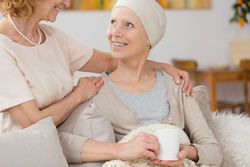Combination Chemotherapy – Medicine’s Attempt to Beat Darwin
Evolutionary biologists know that DNA mutations lead to change. Change that increases survivorship is expressed with increased frequency in subsequent generations. Change that weakens a species is bred to extinction.
In a healthy human cell line, DNA mutations are rare, occurring at the rate of two errors per 100,000,000 cell divisions. The extraordinary accuracy of replication explains why evolutionary change occurs slowly under normal circumstances. Cancer cells behave differently. They are genetically unstable and are subject to frequent mutations. The rate of DNA errors in cancer cell lines is thought to be 50 to 750 times higher than the norm.
Cancer is a disease of abnormal and uncontrolled cell growth. Cells replicate by growing and dividing. Mutations can occur during DNA replication and cell division. As cancer progresses, the tumor makeup becomes a more heterogeneous mix as mutations happen. The cells in a mature tumor are less similar to each other than the cells in a new tumor are. The diversity makes treatment more difficult if resistant lines have developed in the changing mosaic of cells of the tumor.
Resistance forms in tumor cells through the same micro-evolutionary process that causes bacteria to become resistant to antibiotics.

Asclepius, Greek God of Medicine
Penicillin was once a powerful antibiotic used to treat Staph infections. Today it is rarely prescribed for skin conditions. Bacterial mutations and the overuse of penicillin have created the super-bug MRSA (methicillin-resistant Staph aureus).
Just as bacterial mutations create infections that are resistant to antibiotics, mutations in cancer cell lines create tumors that are resistant to previously effective treatments. Relapses in cancer patients are thought to be the result of a small number of cancer cells that evade death by mutating into a resistant form. Initially, the patient may show great improvement from the treatment until the new strain of the cancer cells storms back.
Goldie and Coleman published an influential paper in 1984 presenting the somatic mutation theory, which said that the bigger the tumor, the more likely that any cell in it is resistant to a given drug. While this idea, which seems valid, helps guide the thinking of researchers and clinicians, it doesn’t help with identifying combinations that can cause remission.
Combination chemotherapy is medicine’s attempt to fight through cell mutation and the development of resistance. Combining two or three chemotherapeutic agents increases the probability of killing the cancer. Cancer cells are attacked by multiple drugs that disrupt different stages of the cell reproduction cycle. Oncology follows a path set by antimicrobial therapy in this respect.
All cells go through four phases during the reproduction cycle: G1, S, G2, and M. Many chemo drugs work only at one phase of the cycle while other drugs are not phase specific. It is logical to attack multiple phases of the cell replication cycle to prevent mutation and resistance from occurring.
Oncologists strategize when developing combinations. The combination may be described as a cocktail or a regimen. (Regimen descriptions usually also include timing and dosage of medicines.) Each agent in the combination is effective against the cancer. The different agents should attack the malignancy through a different mechanism of action. For example, one drug may disrupt DNA replication while a second drug interferes with protein synthesis. Attacking the malignant cells through different mechanisms lessens the chance of a mutated cell line evolving.
 Combination drug selection must also consider toxicities. Good combinations avoid a heavy double insult to any one organ system. Drug toxicity can have an additive effect so oncologists want to avoid poisoning any part of the body too much. Each drug’s effect on bone marrow, liver and renal function must be considered.
Combination drug selection must also consider toxicities. Good combinations avoid a heavy double insult to any one organ system. Drug toxicity can have an additive effect so oncologists want to avoid poisoning any part of the body too much. Each drug’s effect on bone marrow, liver and renal function must be considered.
Kinase inhibitors and Immunotherapy
Another way combinations may be a boon to cancer treatment is in improving the effectiveness of checkpoint inhibitors. These drugs work great for some patients, but the tumors often develop resistance.
Kinase inhibitors, especially if chosen to target the relevant oncogene, also are effective against tumors before resistance develops. But the good news is that the kinase inhibitors may sensitize the malignant cells that remain to immunotherapy.
Evaluation of Chemotherapy Treatment